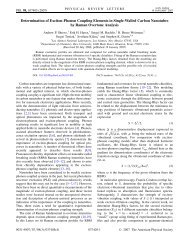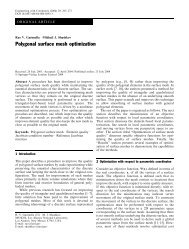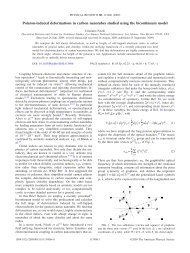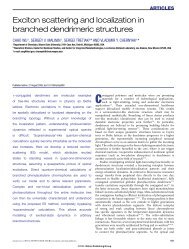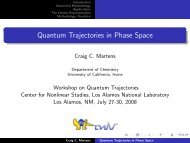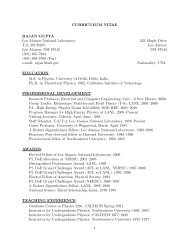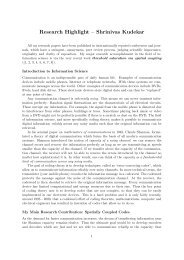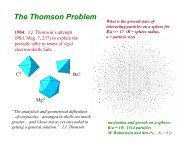Two-Photon Transitions in Quadrupolar and Branched - American ...
Two-Photon Transitions in Quadrupolar and Branched - American ...
Two-Photon Transitions in Quadrupolar and Branched - American ...
Create successful ePaper yourself
Turn your PDF publications into a flip-book with our unique Google optimized e-Paper software.
TPA <strong>in</strong> <strong>Quadrupolar</strong> <strong>and</strong> <strong>Branched</strong> Chromophores J. Phys. Chem. B, Vol. 111, No. 32, 2007 9473<br />
TABLE 4: Selected Bond Lengths for Chromophores 3 <strong>and</strong><br />
4 (<strong>in</strong> Å) for Both Ground State (GS) <strong>and</strong> Relaxed Excited<br />
State (ES) Geometries a<br />
central<br />
CsC<br />
CsC next<br />
to v<strong>in</strong>ylene<br />
CdCof<br />
v<strong>in</strong>ylene<br />
central<br />
CsN<br />
term<strong>in</strong>al<br />
CsN<br />
3-GS 2.77 2.78 2.52 2.62 2.62<br />
4-GS 2.77 2.78 2.52 2.68 2.62<br />
4-ES-B1 or B2 2.78 2.79 2.53 2.69 2.62<br />
4-ES-B3 2.69 2.73 2.58 2.67 2.62<br />
3-ES 2.69 2.74 2.59 2.62 2.62<br />
a B1, B2, <strong>and</strong> B3 label the three different branches of molecule 4.<br />
Figure 3. Experimental TPA cross section of quadrupolar compounds<br />
1-3 <strong>in</strong> toluene.<br />
ext<strong>in</strong>ction coefficients. However, a concomitant slight reduction<br />
of the b<strong>and</strong>width leads to a smaller <strong>in</strong>crease of the transition<br />
dipole moment.<br />
The lowest excited state (ES) optimal geometries of chromophores<br />
1-3 <strong>in</strong>dicate that the structure of the stilbenyl<br />
branches becomes planar with reduced bond length alternation<br />
(Figure 2 <strong>and</strong> Table 4; Support<strong>in</strong>g Information Figures S4 <strong>and</strong><br />
S5). Due to additional planarization of the central biphenyl core<br />
observed for compounds 1 <strong>and</strong> 2, all three quadrupoles have<br />
fully planar ES geometries. As a result, emission spectra of<br />
fluorophores 2 <strong>and</strong> 3 are almost identical.<br />
Similar to GS geometries, all quadrupoles 1-3 have nearly<br />
centrosymmetric structures <strong>in</strong> the ES as well. Indeed, ground<br />
<strong>and</strong> excited state dipole moments calculated for the ES<br />
geometries are either vanish<strong>in</strong>g or relatively small (Table 2).<br />
Chemical substitution along the series 1-3 leads to a slight<br />
<strong>in</strong>crease of the radiative lifetime, well reproduced by the<br />
calculated values. As a consequence of the correspond<strong>in</strong>g slight<br />
decrease of the radiative decay rates, the fluorescence quantum<br />
yields slightly decrease. Equation 4 <strong>and</strong> the data <strong>in</strong> Table 3 show<br />
that the <strong>in</strong>crease of the radiative lifetime between 1 <strong>and</strong> 2 is<br />
ma<strong>in</strong>ly due to the red shift of the emission while that between<br />
2 <strong>and</strong> 3 corresponds to a decrease of the transition dipole<br />
moment correspond<strong>in</strong>g to the fluorescence process. This is<br />
<strong>in</strong>deed confirmed by the calculated values. However, the<br />
remarkable agreement between experimental <strong>and</strong> calculated<br />
values deserves some comments. In fact, it partly results from<br />
error cancellation of overestimated transition dipole moments<br />
<strong>and</strong> underestimated transition energies. In addition, solvent<br />
effects are accounted for by means of the Lorentz local field<br />
factor.<br />
Experimental TPA spectra of quadrupolar compounds 1-3<br />
are shown <strong>in</strong> Figure 3. The first TPA maximum of each of the<br />
three chromophores is significantly blue shifted with respect to<br />
twice the one-photon absorption maximum <strong>and</strong> shows up<br />
between 690 <strong>and</strong> 760 nm. This is directly related to the nearly<br />
centrosymmetric molecular symmetry of these quadrupoles that<br />
br<strong>in</strong>gs the first excited electronic state to be almost TPA<br />
forbidden. However, the red shifts observed for the one-photon<br />
absorption spectra when go<strong>in</strong>g from chromophore 1 to 3 are<br />
observed for the different TPA peaks as well.<br />
When analyz<strong>in</strong>g the magnitude (i.e., maximum) of the first<br />
TPA b<strong>and</strong> of chromophores of different structures, it is of<br />
particular <strong>in</strong>terest to compare <strong>in</strong>tr<strong>in</strong>sic TPA cross sections (i.e.,<br />
normalized by the square of the effective number of electrons,<br />
determ<strong>in</strong>ed us<strong>in</strong>g the count<strong>in</strong>g method described <strong>in</strong> ref 107) as<br />
proposed by Kuzyk <strong>and</strong> co-workers. 108 This provides a metric<br />
for comparison. In the case of chromophores 1-3, we observe<br />
that the <strong>in</strong>tr<strong>in</strong>sic TPA is significantly <strong>in</strong>creased on go<strong>in</strong>g from<br />
compound 1 to compound 3 (Table 5), although the molecules<br />
have the same effective number of electrons. This clearly is<br />
related to the nature of the connect<strong>in</strong>g unit (double bond versus<br />
triple bond for chromophore 2 compared to chromophore 1)<br />
<strong>and</strong> of the core (fluorenyl versus biphenyl for chromophore 3<br />
compared to chromophore 2). We observe that, unsurpris<strong>in</strong>gly,<br />
this <strong>in</strong>crease parallels both an <strong>in</strong>crease of the transition dipole<br />
<strong>and</strong> a decrease of the energy gap between the ground <strong>and</strong> first<br />
excited state (Table 3) <strong>in</strong> agreement with <strong>in</strong>creased conjugation.<br />
In addition, the enhancement of the <strong>in</strong>tr<strong>in</strong>sic TPA is much<br />
stronger when replac<strong>in</strong>g the v<strong>in</strong>yl l<strong>in</strong>ker by an ethynylene l<strong>in</strong>ker<br />
than by a biphenyl core (Figure 3), <strong>in</strong>dicat<strong>in</strong>g that the lower<strong>in</strong>g<br />
of the energy gap is correlated <strong>in</strong> that case with the <strong>in</strong>tr<strong>in</strong>sic<br />
TPA magnitude.<br />
All three chromophores show a second strong TPA b<strong>and</strong> <strong>in</strong><br />
the visible green-yellow region. Although these latter b<strong>and</strong>s are<br />
closer to the one-photon resonances (Table 2), the two-photon<br />
excited fluorescence <strong>in</strong>tensity still clearly varies as the square<br />
of the excitation power <strong>and</strong> no contributions from s<strong>in</strong>gle-photon<br />
absorption were observed at these shorter wavelengths. Moreover,<br />
<strong>in</strong> the case of the strongest transition (compound 3),<br />
fluorescence anisotropies significantly <strong>in</strong> excess of 0.4 (the<br />
s<strong>in</strong>gle-photon maximum) are observed together with a marked<br />
absorption anisotropy, Ω ) σ (2) circular/σ (2) l<strong>in</strong>ear, <strong>in</strong>dicat<strong>in</strong>g that this<br />
<strong>in</strong>tense TPA b<strong>and</strong> results from true TPA processes orig<strong>in</strong>at<strong>in</strong>g<br />
from the participation of higher-ly<strong>in</strong>g excited states. Polarized<br />
two-photon photoselection <strong>and</strong> the structure of the transition<br />
tensor will be discussed <strong>in</strong> detail <strong>in</strong> a forthcom<strong>in</strong>g paper.<br />
In fact, calculated TPA spectra (Figure 4) confirm these<br />
experimental f<strong>in</strong>d<strong>in</strong>gs. The TPA maximum <strong>in</strong> the NIR region<br />
can be assigned to the second excited state that undergoes<br />
significant charge transfer from the periphery to the core upon<br />
excitation (Figure 2). Virtual states <strong>in</strong>volved <strong>in</strong> the TPA process<br />
are ma<strong>in</strong>ly the first <strong>and</strong> fourth excited states that bear significant<br />
oscillator strengths. Higher-ly<strong>in</strong>g excited states such as the third<br />
one (Figure 2) are responsible for significant TPA activity <strong>in</strong><br />
the visible red region. Large TPA responses further to the blue<br />
(i.e., <strong>in</strong> the visible green region) are also predicted by calculations<br />
<strong>and</strong> correspond to excited states ly<strong>in</strong>g beyond the 10th<br />
excited state. An accurate description of these high-energy<br />
contributions would require <strong>in</strong>corporation of a very large number<br />
of excited states which expla<strong>in</strong>s the quantitative disagreement<br />
between calculated (Figure 4) <strong>and</strong> experimental data (Figure<br />
3) <strong>in</strong> that spectral range.<br />
Quantitative comparison between calculated <strong>and</strong> experimental<br />
TPA cross sections <strong>in</strong> the red-NIR region deserves some<br />
comments, as calculated values are systematically larger than<br />
experimental ones (Table 5). To beg<strong>in</strong> with, calculations have<br />
been performed us<strong>in</strong>g a fixed l<strong>in</strong>e width of 0.1 eV while<br />
experimental values are almost 3 times larger (Table 5). Also,<br />
as already mentioned, calculated transition dipole moments are



